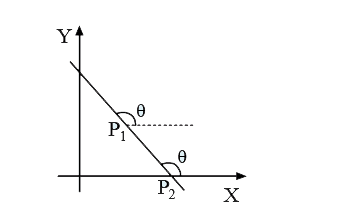A slip of paper is given to a person A who marks it either with a plus sign or a minus sign. The probability of his writing a plus sign is 1/3. A passes the slip to B, who may either leave it alone or change the sign before passing it to C. Next C passes the slip to D after perhaps changing the sign. Finally D passes it to a refere after perhaps changing the sign. B,C,Deachchan≥thesignwithprobability2//3.<br>TheprobabilitytˆtherefereeobservesaplussignontheslipifitisknowntˆA wrote a plus sign is
14/27
16/27
13/27
17/27
The correct Answer is:C
To solve the problem, we need to find the probability that the referee observes a plus sign on the slip given that A wrote a plus sign. Let's denote the events as follows:
- Let A+ be the event that A writes a plus sign.
- Let R+ be the event that the referee observes a plus sign.
We are given:
- P(A+)=13
- The probability that B, C, or D changes the sign is 23.
- The probability that B, C, or D does not change the sign is 13.
Step 1: Calculate the probability that the referee sees a plus sign given that A wrote a plus sign.
When A writes a plus sign, we need to consider the actions of B, C, and D:
1. No one changes the sign:
- The probability that B does not change the sign is 13.
- The probability that C does not change the sign is 13.
- The probability that D does not change the sign is 13.
- Thus, the probability that none of them changes the sign is:
P(No change)=(13)3=127
2. Exactly one person changes the sign:
- There are 3 ways to choose which one of B, C, or D changes the sign. The probability that one specific person changes the sign and the other two do not is:
P(One change)=3⋅(23)⋅(13)2=3⋅23⋅19=627=29
3. Exactly two people change the sign:
- There are 3 ways to choose which two of B, C, or D change the sign. The probability that two specific people change the sign and one does not is:
P(Two change)=3⋅(23)2⋅(13)=3⋅49⋅13=1227=49
4. All three change the sign:
- The probability that all three change the sign is:
P(All change)=(23)3=827
Step 2: Combine these probabilities to find P(R+|A+)
The referee sees a plus sign if:
- No one changes the sign (probability 127).
- Exactly two change the sign (probability 49).
Thus, we can sum these probabilities:
P(R+|A+)=P(No change)+P(Two change)=127+49
To add these fractions, we convert 49 to a fraction with a denominator of 27:
49=4⋅39⋅3=1227
So,
P(R+|A+)=127+1227=1327
Final Answer
The probability that the referee observes a plus sign on the slip if it is known that A wrote a plus sign is:
1327
- Let R+ be the event that the referee observes a plus sign.
- P(A+)=13
- The probability that B, C, or D changes the sign is 23.
- The probability that B, C, or D does not change the sign is 13.
- The probability that B does not change the sign is 13.
- The probability that C does not change the sign is 13.
- The probability that D does not change the sign is 13.
- Thus, the probability that none of them changes the sign is:
P(No change)=(13)3=127
- There are 3 ways to choose which one of B, C, or D changes the sign. The probability that one specific person changes the sign and the other two do not is:
P(One change)=3⋅(23)⋅(13)2=3⋅23⋅19=627=29
- There are 3 ways to choose which two of B, C, or D change the sign. The probability that two specific people change the sign and one does not is:
P(Two change)=3⋅(23)2⋅(13)=3⋅49⋅13=1227=49
- The probability that all three change the sign is:
P(All change)=(23)3=827
- No one changes the sign (probability 127).
- Exactly two change the sign (probability 49).
P(R+|A+)=P(No change)+P(Two change)=127+49
49=4⋅39⋅3=1227
So,
P(R+|A+)=127+1227=1327
The probability that the referee observes a plus sign on the slip if it is known that A wrote a plus sign is:
1327
Topper's Solved these Questions
- BOOK - CENGAGE ENGLISHCHAPTER - PROBABILITYEXERCISE - Multiple Correct Answer13videos
PROBABILITY
- BOOK - CENGAGE ENGLISHCHAPTER - PRINCIPLE OF MATHEMATICAL INDUCTIONEXERCISE - Sovled Examples22videos
PRINCIPLE OF MATHEMATICAL INDUCTION
- BOOK - CENGAGE ENGLISHCHAPTER - PROBABILITY I EXERCISE - JEE Advanced7videos
PROBABILITY I
Similar Questions
A slip of paper is given to a person A who marks it either with a plus sign or a minus sign. The probability of his writing a plus sign is 1/3. A passes the slip to B, who may either leave it alone or change the sign before passing it to C. Next C passes the slip to D after perhaps changing the sign. Finally D passes it to a refere after perhaps changing the sign. B,C,Deachchan≥thesignwithprobability2//3.
If the refree observes a plus sign on the slip then the probability that A originally wrote a plus sign isView SolutionMontreal protocol was signed in
View SolutionFind the sign of the slope and its nature.
 View Solution
View Solutionin an atomic orbital the sign of lobes indicate the
View SolutionDefine heat and work and mention their sign conventions.
View SolutionWhat is the sign convention for heat ?
View SolutionIn the questions , if the charges with the same sign are interchanged then the work doen is
View SolutionNumber of ways in which 5 plus (+) signs and 5 minus (-) signs be arranged in a row so that no two minus signs are together is
View SolutionIn an atomic orbital , the sign of lobes indicates the
View SolutionWrite the significance of plus and minus sign shown in representing the orbitals.
View Solution
